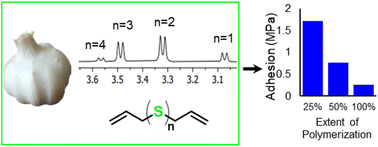Allyl sulfides in garlic oil initiate the formation of renewable adhesives†
Abstract
The development of inverse vulcanization has provided a simple method to create sulfur-based materials. The low cost, ease of synthesis, and variety of applications has led to a rapid expansion of the field. These polysulfides can be synthesized with a wide range of sulfur contents (20–90% S) depending on the desired properties. Garlic essential oil (GEO) is composed of allyl sulfides, which offers the opportunity to replace sulfur, a petroleum byproduct, with a renewable monomer to make materials with moderate sulfur contents. Using a one-pot, solvent-free synthesis, comparable to inverse vulcanization, GEO can be polymerized to create renewable adhesives at temperatures as low as 120 °C with reaction times decreasing at higher temperatures. Here we have explored the composition of garlic oil from a variety of commercial suppliers by NMR. Through simple 1H NMR analysis, the major sulfur-containing compounds of GEO can be identified and differentiated by sulfur rank. These data were used to select garlic oils with varied compositions to examine the impact on the poly(GEO) properties using solubility, gel permeation chromatography, differential scanning calorimetry, and thermogravimetric analysis as well as adhesive performance. GEO was then subjected to different reaction times and temperatures and the degree of polymerization was monitored by 1H NMR. The polysulfides were then evaluated as adhesives at different extents of polymerization to better understand how the reaction conditions impact adhesive performance. The failure mode and mechanical properties of the polymers were analyzed using measurements of maximum adhesion strength and work of adhesion. This study has provided a better understanding of polymers formed from GEO, providing a viable route to developing renewable, S-based materials.

- This article is part of the themed collection: Pioneering Investigators 2023


 Please wait while we load your content...
Please wait while we load your content...